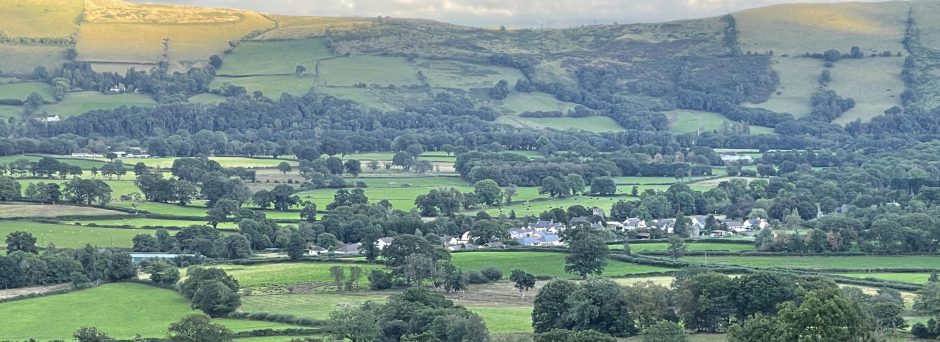An Introduction to the Survey of Higher Plants made by M & J Iliff 2007
In former times Cwm Rhaeadr would have been part of the Mynydd Mallaen moor, whose side valleys are often sheltered and species rich.
The moorland character is revealed by plants like Blechnum (Hard Fern) which is very frequent, Juncus squarrosus (Heath Rush) and Wahlenbergia (Ivy-leaved Bellflower).
It is noticeable that the common hedgerow plants like the Red Campion and Cow Parsley have not been seen.
We know that more recently there have been many small farms on the site, but hardly a trace of any of these remain in the form of common weeds like Nettles and Docks which can usually be found as evidence of habitation.
The only obvious instance consists of two enormous Box trees and a variety of large-flowered Victorian Daffodils growing not far from the buildings presently used by the scouts (Cwm Rhaeadr barns).
Due to the shading effect of the trees the greater part of the species are to be found, fortunately for the passer-by, on the roadside verges: many of these are very species rich, showing a great variety of composites, vetches, clovers and umbellifers and include in the drier parts, an abundance of the small pink Centaury.
The ditches often have an abundance of Rushes and Sedges and the carpet-forming pink Bog Pimpernel.
Perhaps the most varied area is the riverside path from the bridge to the hairpin bend below the waterfall. Adjacent to the bridge is quite a large colony of the graceful, many-branched Equisitum sylvaticum (Wood Horsetail), only appearing in the summer months. Also alongside the path are to be found Solidago (Golden Rod), Wahlenbergia and large clumps of Politricum (Haircrop Moss).
Much of the variety of plantlife in Cwm Rhaeadr lies in its abundance of Mosses and Liverworts which are fully considered in the parallel survey by Mr Ray Woods.
Download list of Latin, English & Welsh plant names (Excel format)
Cwm Rhaeadr : Cyflwyniad iâr Arolwg o Uwch Blanhigion a wnaed gan M a J Iliff 2007
Yn y gorffennol, roedd Cwm Rhaeadr yn rhan o waun Mynydd Malláen, y mae ei hochrau’n aml yn gysgodol ac yn gyfoethog o ran rhywogaethau.
Datgelir y cymeriad gweundirol gan blanhigion megis Blechnum (Gwibredynen), sy’n digwydd yn fynych, Juncus squarrosus (brwynen droellgorun) a Wahlenbergia (clychlys dail-eiddew).
Sylwir na welwyd y planhigion gwrych cyffredin megis gludlys coch (blodau neidr / blodau taranau) a gorthyfail.
Gwyddom fod nifer o ffermydd bychain wedi bod ar y safle’n fwy diweddar, ond nid oes braidd dim o olion y rhain o ran chwyn cyffredin megis danadl/dynaint a dail tafol a geir fel arfer fel tystiolaeth o anheddiad.
Yr unig enghraifft amlwg yw dau bren bocs enfawr ac amrywiaeth o gennin Pedr blodau mawr o oes Victoria sy’n tyfu nid nepell o ysguboriau Cwm Rhaeadr (yr adeiladau a ddefnyddir ar hyn o bryd gan y sgowtiaid).
O ganlyniad i effaith cysgodi’r coed, mae’r rhan fwyaf o’r rhywogaethau’n digwydd, yn ffodus i’r sawl sy’n pasio heibio, ar ymylon yr heolydd: mae llawer o’r rhain yn gyfoethog iawn o ran rhywogaethau, gan ddangos amrywiaeth fawr o blanhigion cyfansawdd, ffacbys, meillion ac wmbellifferau ac, yn y mannau sychaf, y ganrhi bach pinc yn doreithiog.
Yn y ffosydd yn aml, ceir helaethrwydd o frwyn a hesg ac o wlyddyn-Mair y gors pinc, sy’n lledu fel carped.
Yr ardal fwyaf amrywiol efallai yw’r llwybr glan afon o’r bont i’r bachdro islaw’r rhaeadr. Gerllaw’r bont ceir cytref eithaf mawr o Equisitum sylvaticum (marchrawn y coed), planhigyn hardd, â llawer o ganghennau, sy’n ymddangos yn yr haf yn unig. Hefyd ar hyd y llwybr, ceir Solidago (eurwiail), Wahlenbergia a chlystyrau o Polytrichum (brigerfwsoglau).
Mwsoglau a llysiau’r afu yw llawer o blanhigion Cwm Rhaeadr, ac ystyrir y rhain yn llawn yn arolwg Mr Ray Woods.
Lawrlwythwch restr o enwau planhigion yn Gymraeg, Saesneg a Lladin


